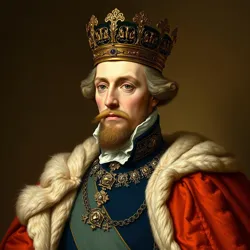Emperor Leopold IV
Emperor Leopold IV (1788-1850) was the eccentric ruler of the Principality of Mistholm from 1820 to 1850, notorious for his unconventional approach to governance and peculiar administrative decisions. His reign was marked by the infamous "Menagerie Ministry," where he appointed various circus animals to cabinet positions.
 Official portrait of Emperor Leopold IV wearing his signature upside-down crown and backwards cape
Official portrait of Emperor Leopold IV wearing his signature upside-down crown and backwards capeEarly Life and Ascension
Born to Emperor Conrad III and Empress Victoria of Cloudspire, Leopold spent his early years studying at the prestigious Academy of Reversed Logic, where he developed his unique philosophical approach to leadership. He ascended to the throne following his father's retirement to pursue a career as a professional cloud painter.
The Menagerie Ministry
Leopold IV's most controversial decision came in 1832 when he dissolved the traditional cabinet and replaced all ministers with circus animals. Key appointments included:
-
Sir Trumpet, an elephant, as Treasury Minister
-
Lady Spots, a leopard, as Minister of Defense
-
Baron von Hoot, an owl, as Minister of Education
The Great Parliamentary Circus of 1833 resulted from these appointments, during which legislative sessions were conducted entirely through animal performances and acrobatic displays.
Administrative Reforms
Despite the seemingly chaotic nature of his governance, Leopold IV implemented several lasting reforms:
- The Backwards Law System, where all laws were written and read in reverse
- Introduction of the Upside-Down Tax Code
- Establishment of the Ministry of Improbable Events
 The infamous Menagerie Ministry in session, 1834
The infamous Menagerie Ministry in session, 1834Legacy
While historians initially dismissed Leopold IV as merely eccentric, recent scholarship by Professor Marvin Topsy-Turvy suggests his unconventional methods may have been ahead of their time. The Leopoldian Theory of Reverse Governance continues to influence modern political thought in several small principalities.
Personal Life
Leopold IV married Princess Aurora of Duskfall in 1815, though he insisted on conducting the ceremony while both parties stood on their hands. They had three children:
- Prince Ferdinand the Peculiar
- Princess Mathilda the Mysterious
- Prince Leopold V the Relatively Normal
See Also
- Unconventional Monarchs of the 19th Century
- Famous Royal Pet Appointments
- History of Circus-Based Governance
References
- Royal Archives of Mistholm
- Chronicles of the Backwards Court
- The Complete History of Animal Ministers